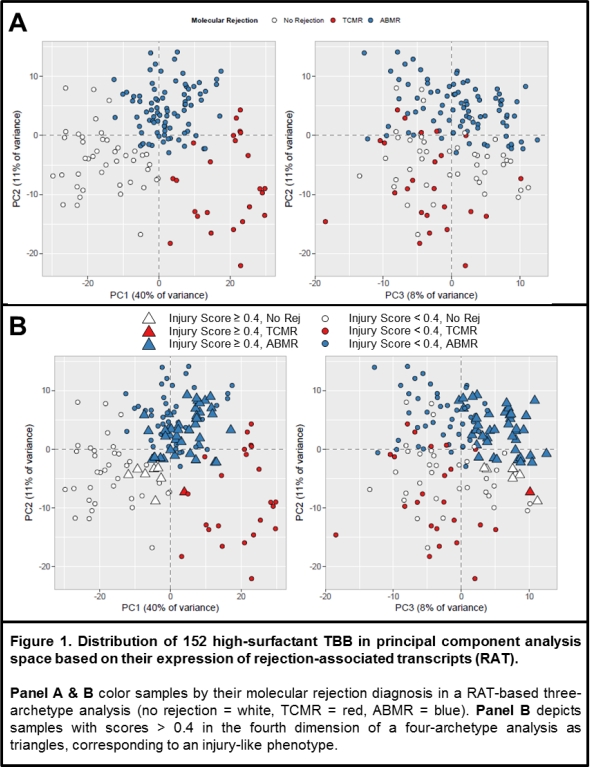Molecular Phenotypes of Injury and Rejection in Lung Transplant Transbronchial Biopsies
University of Alberta, Edmonton, Canada.
Meeting: 2018 American Transplant Congress
Abstract number: 76
Keywords: Gene expression, Lung transplantation, Multicenter studies
Session Information
Session Name: Concurrent Session: Lung: From Allocation to Outcomes
Session Type: Concurrent Session
Date: Sunday, June 3, 2018
Session Time: 2:30pm-4:00pm
 Presentation Time: 2:42pm-2:54pm
Presentation Time: 2:42pm-2:54pm
Location: Room 303
Purpose: Histologic assessment of lung transplant transbronchial biopsies (TBB) is not reproducible and cannot assess antibody-mediated rejection (ABMR). Molecular diagnostics (MMDx) successfully identified rejection in heart and kidney transplants, and we adapted MMDx to TBB using 453 rejection-associated transcripts (RAT) derived in kidneys and validated in hearts.
Methods: 242 single TBB bites from 211 recipients at 7 centers were processed using microarrays. Of those, 152 samples with high surfactant expression (reflecting alveoli) were analyzed. Molecular rejection scores (non-rejection, TCMR, ABMR) were assigned to each TBB using 3-phenotype archetypal analysis (AA) trained on RAT expression (JHLT 36:1192). To explore possible injury-related phenotypes in TBB we performed an independent 4-phenotype AA using RAT expression.
Results: 3-phenotype AA of TBB identified ABMR, TCMR, and non-rejection phenotypes (Figure 1A). Non-rejection scores correlated with absence of rejection transcripts ([rho]S=-0.94), especially effector T cell and NK cell transcripts (NKG7, KLRD1, PRF1). TCMR scores correlated with TCMR transcripts (ANKRD22, CTLA4, ADAMDEC1; [rho]S=0.91). ABMR scores correlated with ABMR transcripts ([rho]S=0.80), particularly endothelial transcripts (CAV1, TEK, ROBO4).
4-phenotype AA revealed a new injury phenotype correlated with macrophage transcripts ([rho]S=0.71). Scores >0.4 in this fourth dimension were described as injury (Figure 1B) and were reported independently of the rejection phenotypes from the 3-phenotype AA. The injury score correlated weakly with all-rejection transcripts ([rho]S=0.2) and represents macrophage-rich inflammation that may arise either from rejection or other disease processes.
Conclusion: MMDx describes TBB as a composite of rejection (TCMR and ABMR) and a macrophage-rich injury state. We believe that clinical phenotyping with two TBB bites to mitigate heterogeneity in alveolar content (compared to up to 10 for histology) will provide a new, safer approach that will change care by offering the first accurate assessments of TCMR and ABMR. ClinicalTrials.gov: NCT02812290.
CITATION INFORMATION: Parkes M., Halloran K., Famulski K., Halloran P., The INTERLUNG Study Group Molecular Phenotypes of Injury and Rejection in Lung Transplant Transbronchial Biopsies Am J Transplant. 2017;17 (suppl 3).
To cite this abstract in AMA style:
Parkes M, Halloran K, Famulski K, Halloran P, Group TheINTERLUNGStudy. Molecular Phenotypes of Injury and Rejection in Lung Transplant Transbronchial Biopsies [abstract]. https://atcmeetingabstracts.com/abstract/molecular-phenotypes-of-injury-and-rejection-in-lung-transplant-transbronchial-biopsies/. Accessed December 26, 2025.« Back to 2018 American Transplant Congress

